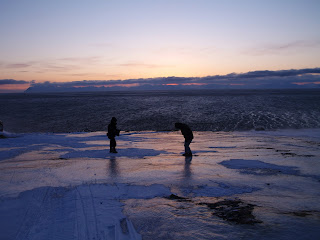Thursday, July 1, 2010
Thursday, June 24, 2010
Wednesday, June 23, 2010
Tuesday, June 22, 2010
Safety Layer
The aim with our first layer is that it should function as a regular first layer but with the life saving function by heating the body in emergency conditions.
If an accident occurs it is hard to keep the heat inside the body. The conductive yarns knitted in the pattern will be heated when electricity runs through them. In addition, if an injury occurs, our first layer will be able to sense whenever the body temperature drops under the safety range and it will start releasing heat to the body automatically.


Safety Tube
It's meant to be a quick and easy way to be protected from wind and coldness, if necessary. The shelter has the shape of a tube which has an adjustable length so one or two people can fit in it. The tube has a self-supporting design, this is due to a spiral of tubes filled with air. This fabric is coated with aluminum which will reflect the cold coming from the outside but it will keep and reflect instead some of the heat generated from the body inside the tube.


Safety Shelter
The idea is that everyone should have his own “home”. It could be used for both homeless and victims from nature disasters. The safety shelter is a combination of a mattress, a sleeping bag and a wind shelter.
This rip stop fabric coated with aluminum foil, has a thermo chromic print sensitive to temperatures inferior to 8ºC and photo luminescent colors which low in the dark.


Mobile home
The mobile home is a combination of a sledge and a tent. When you reach the campsite the tent is folded out from the sledge and the sledge is used as a “floor” surface.
There is a photo luminescent print in the shape of the star constellations. On the outside it will be possible to attach movable solar panels so that the electric equipment can be charged.



Saturday, June 19, 2010
Solar technology
The Solar Power Plastic panels used as experiments and samples have been sponsored by Konarka Technologies, Inc.
The prototypes have been developed on real scale, therefore, they are not functional yet. In the following step, the conductive thread will be heated thanks to the rechargeable battery which will be sequentially connected to the solar cells on the outer layer of the tent or sledge during day light.
 Together with the "security layer", a series of printed patterns has been presented. The concept behind the design, is to hide or integrate solar technology into the fabric also considering the aesthetics of the textile.
Together with the "security layer", a series of printed patterns has been presented. The concept behind the design, is to hide or integrate solar technology into the fabric also considering the aesthetics of the textile.
Colors, shapes and textures remind of organic forms and natural nordic landscapes, where, for instance, leaves change colors in autumn and ice melts during summer.

Anna Madella
Sunday, April 25, 2010
Wednesday, April 14, 2010
Sunday, April 11, 2010
Exhibition opening
Wednesday, March 31, 2010
Monday, March 29, 2010
Exhibition "Passage to Water" Makerere Art Gallery

On Thursday the 1st of April we will open up an exhibition that will take place at the Makerere Art Gallery.
The exhibition will start with a presentation about Smart textiles and our project and then lead into an interactive workshop.
Since the flow of water is elementary for our project the aim for the exhibition is to involve the community, in this case the art students, to collaboratively build a sculpture wich will lead the water from one point to another. This refers back to our solar water system and the community involvement. The aim for the exhibition is to show how science is leading to art.
textile water cleaning system
Integrity 2010, NATURE, is pleased to announce a new context of making smart textiles useful to improve human conditions in highly urbanized areas while preserving traditional values. We are an interdisciplinary group from the Swedish School of Textiles, members Shufei Wang, Sarah Torkelsson, Jeannine Han, Marina Rehbein.
The formation of community projects in rural areas in Uganda such as womens handicraft groups is used as a role model to create a community textile solar water heating and cleaning system that makes use of the common rain falls in Uganda.
The system is based on three processes, harvesting rain water, storing it and heating it with the help the sunlight. Several parameters influencing these processes need to be taken into consideration. Height, surface, structure, weight, time, temperature, volume and gravity.
The flexibility of the textile material makes it possible to meet the demand of a highly densed urban area that quickly develops in an architectual unplanned way such as shanty towns of Kampala.
The system is based on urbanisation problems and the strong culture in african societies to build constructions which emphazise the individual and the community.
The formation of community projects in rural areas in Uganda such as womens handicraft groups is used as a role model to create a community textile solar water heating and cleaning system that makes use of the common rain falls in Uganda.
The system is based on three processes, harvesting rain water, storing it and heating it with the help the sunlight. Several parameters influencing these processes need to be taken into consideration. Height, surface, structure, weight, time, temperature, volume and gravity.
The flexibility of the textile material makes it possible to meet the demand of a highly densed urban area that quickly develops in an architectual unplanned way such as shanty towns of Kampala.
The system is based on urbanisation problems and the strong culture in african societies to build constructions which emphazise the individual and the community.
Monday, March 22, 2010
Subscribe to:
Comments (Atom)









































